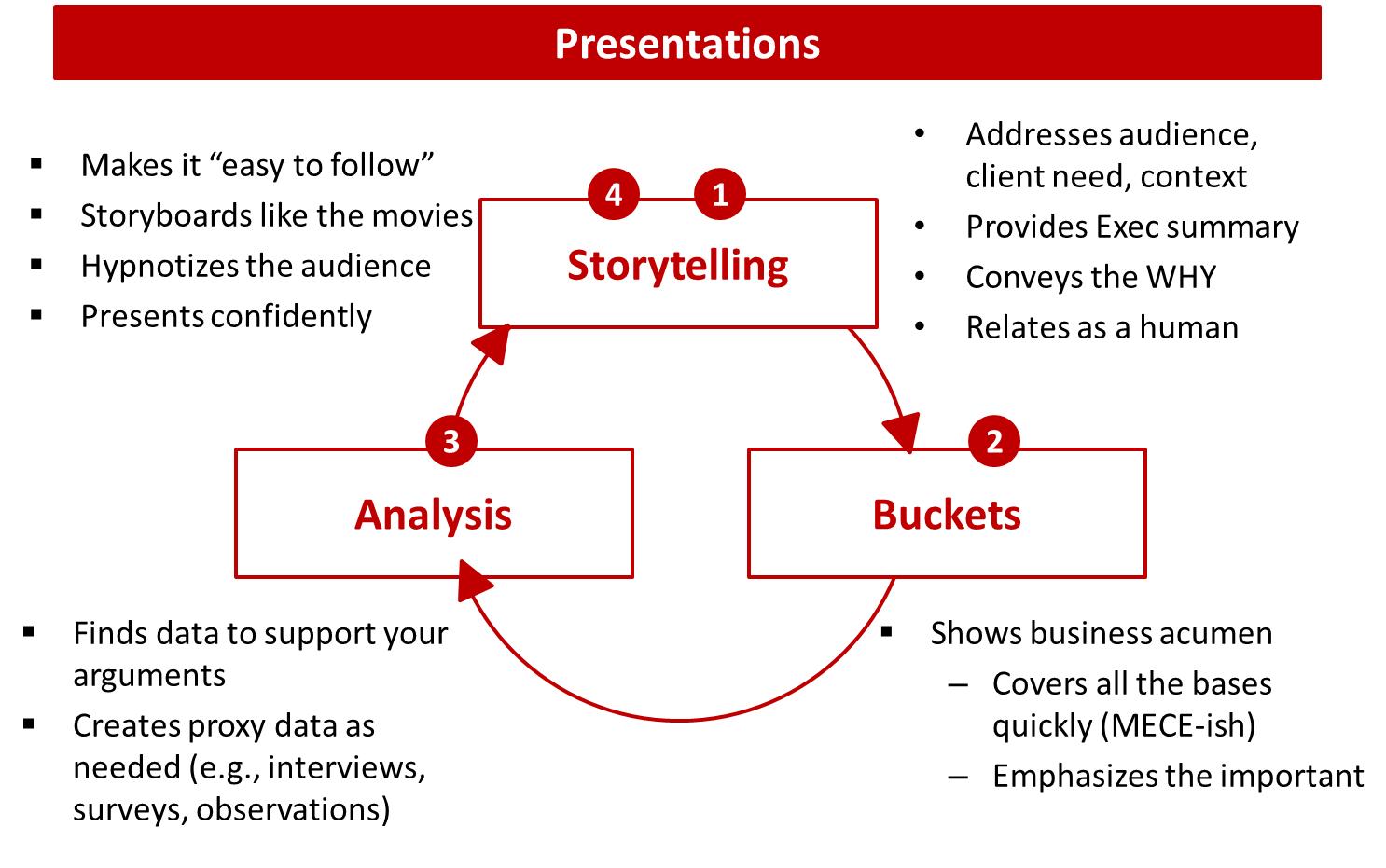1.1 Start with the audience
Depending on the case (read: the client) the tone of the presentation and talk could be very different. Are they a non-profit focused on alleviating hunger or a B2B software company. Also, who will be in the room? Will the client themselves be there, or is a set of slightly uninformed, third-party judges?
In consulting world, questions might be:
- How much context does the audience already have?
- Is this a kick-off meeting, or an executive status report?
- How many people are in the room, will it be 3 people or 30?
- How long is the meeting?
- Is this a finance crowd (better have your numbers) or a sales crowd (get to the point quickly)?
- How do you want them to feel afterwards?
1.2 Provide an executive summary
This is a no-brainer. Start with the punch line. What are the insights and the recommendations? Executive are busy, a little bit grumpy, and distracted. Make it easy for them to focus. Don’t waste their time.
1.3 Convey the WHY, relate to them
As Simon Sinek so famously says, “Start with the WHY“. Why should the audience care about what you are saying? WIIFM? Make sure this topic is relevant, of consequence, and worth studying.
2.1 Buckets, buckets, buckets
Talk to any consultant and they will talk about putting things into buckets. Organize the messy data. Provide some structure, scaffolding, sequencing, orders of magnitude to the content. As a manager, it’s critically important that you divvy up the work – so that all the grinders know exactly what they should be doing.
2.2 Show business acumen
This is where consultants earn their money. Consultants excel at seeing patterns – like matching a jigsaw puzzle. They are a quick study, and enjoy the game of hypothesis-based consulting (read: guessing your way to the answer). Scope the project down, vet out the hidden assumptions. Use frameworks to guide the problem-solving. Show your thinking. At this point, you need strong opinions, loosely held.
2.3 Emphasize the right things
Yes, this is the Pareto principle (80/20). Know what is important. Find the 1st domino. What’s the one thing? Prioritize for yourself and the audience. The world is incredibly non-linear (read: lumpy), so think deeply about what’s most important and why. Prioritize.
3.1 Find the (right) data (quickly)
Take your ideas/hypotheses and see if they work. You’ve got experience and studied up on a topic. You’ve got a hunch, so now it’s time to go for it. Find the data that proves you are right, and put it in excel to analyze. Or if it’s not readily available – create some new data (surveys, interviews). It’s okay if you’re wrong. Yes, it sucks, but it’s not an entirely lost cause; it means that you know what the answer is NOT. Null set.
3.2. Work (a little bit) lazier
Yes, you can do industry research, look at best practices, or conduct competitive intelligence. However, be smart. Follow your curiosity (yes), become a mini-expert (yes), but don’t “boil the ocean”. Mindless research = bad. Be lazy at the right things.
3.3 Test your thinking
You are not perfect. Yes, you have smart ideas, but you do not bat 1.000. Reach out to your manager and get feedback. Stress-test your ideas with your network. Put your idea into the arena for idea fight club. Let the best ideas / arguments win. Don’t suffer silently. Use the power of your teams.
4.1 Make it easy to follow
Don’t use annoying jargon, and pseudo-intelligentsia talk to scare/impress your audience. Put together a storyboard (usually on PowerPoint) that has some flow. Make the slides clean and easy to understand. Simple, with insightful graphics, and strong design. In the end, you want the client saying, “Oh, that makes sense. Let’s do it.”
4.2 Persuade
For me, well put-together presentations are persuasive. They are relevant, provide sufficient context, outline the challenge, present the relevant economic/market drivers, quickly narrow down to a handful of issues to address, explain the logic behind the prioritization, and provide sensible recommendations. As Joe Rogan says, when describing a stand-up comic who is in a flow state. . . “[the audience is so in the moment that] they outsource their thinking to the presenter.”
Relate to the audience as a human. be yourself, and be likable. Be someone they can relate to. Tell a story.
On TV court dramas, the judge sometimes warns the attorneys to “not lead the witness” during cross examination. For me, business presentations are all about leading the witness. Yes, be ethical and never mislead, or misconstrue. And yet, definitely have a point of view and be willing to argue for it. Stand behind your work.
So many tidbits of presentation advice, but in the end: 1) know your stuff 2) proudly stand up for your work product 3) practice – definitely memorize the first 30 seconds of what you will say 4) don’t forget to pause 5) keep it simple and clear 6) have fun (if you’re not having a good time, neither are they).
In summary, one more time. . .
Related posts:
- Presentation Tips for TED’s Chris Anderson
- PowerPoint Sniff Test
- Review of 39pg McKinsey Presentation






Awesome article. Simple and yet very important. Thank you, John
Thanks for reading. Winning.
This is awesome, thank you!!